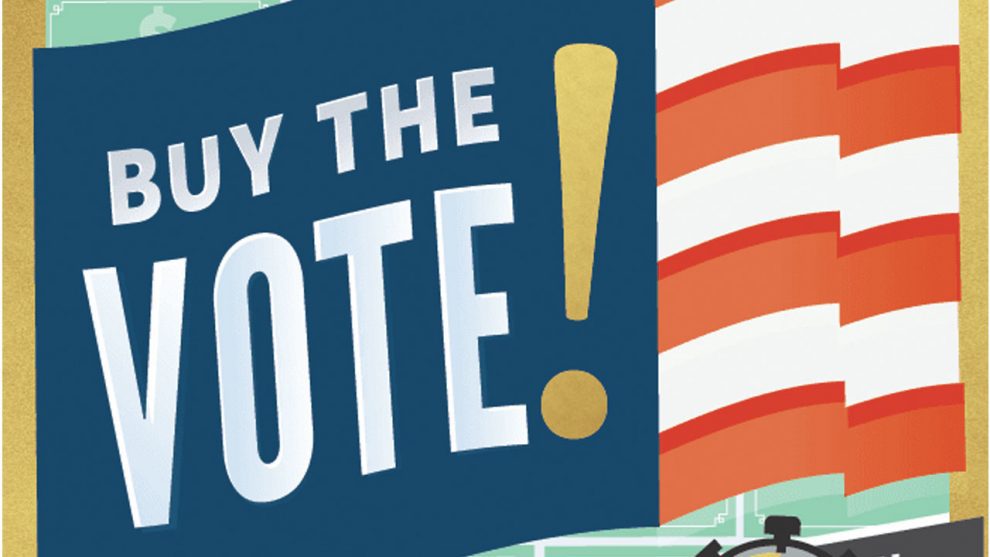Disclaimer: All the photos shown here are from the prototype print-n-play version.
Throughout the decades of tabletop gaming, there have been some excellent examples of using game mechanisms to provide insight on a particular subject. Behind the savvy auction mechanisms of Reiner Knizia’s Modern Art lies criticism of the modern art industry. Bloc by Bloc allowed you to participate in an insurrection against the decaying city and corrupt police force although some of your “allies” may not share the same goals as you, showcasing the difficulties of uprisings. You can also be a corporation with numerous subsidiaries and lobby the government to pass laws that benefit you in Corporate America while understanding how ridiculous the entire political system is in the United States. Perhaps you want to focus on emulating the logistics behind running a political campaign, so a game of Campaign Trail might scratch that itch.
Buy the Vote is none of the above. It is an intelligent auction game wrapping itself with the star-spangled banner that finishes in 15 minutes. Short and sweet.
15 Minutes Of Auctions
By 15 minutes, I do mean 15 minutes in every sense. When you start the game, you set the clock, and it will end at that time. Literally. Don’t worry, this isn’t a real-time game. The idea behind all of this is that you are using money to purchase States to get their electoral votes without any concern about silly things in an election campaign like having a platform or being likable. Some people might point out that this is an inaccurate take on US Elections, but this is a game where five presidential candidates all have equal footing, so we are past the realm of fantasy here.

For a filler game, I was quite impressed with this package. Even though it’s only 15 minutes, it was minutes filled with tough decisions, aggravating situations, and chunky tension throughout the entire session. But I am getting ahead of myself, so let’s rewind a bit and start from the beginning.
On rounds 1, 4, and 7, you will get your income to start bidding on these States. Your job is to get most Electoral votes when the State deck runs out, or the timer has reached zero. At the end of the game, the top two players will become the Presidential Nominee and Running Mate. If they have a combined total of 270 votes, they win together.
In the first round, you will draw 3 cards from the State deck and put them in areas marked State 1, 2, or 3. In the second round, you draw 4 States, and so forth. It will keep increasing until Round 8 where all 9 State stacks are up and running.
Once everyone has examined what’s available, they get their player shields and put them in front of their playmat. This playmat has a grid of all the States, and players will place their bids on the States they want in secret. After everyone has done this, the shields are lifted, and starting from State 1, and onward, they will see who spent the most money to get that State. It keeps going until all the States piles have accounted for, and we move onto the next round.
That’s the entire game.

Anyone Can Grasp It
Before we get into more detail, I want to point out that this is one of the more accessible gateway games I have ever played. Unlike other games mislabeled as “gateway,” this one doesn’t have any weird mechanisms or concepts to internalize. No silly icons, set collection nonsense, or anything strange going on here. Drain the red, white, and blue coloring out of this one, and what remains is a game where you are auctioning for numbered cards. To win the game, you must have the highest number when everything is said and done. Even the greenest non-gamer will understand that higher numbers are better, and spending the most money means you win the bid.
However, a concept cannot work well without good execution, and this is where Buy the Vote shines. It does small yet powerful tweaks to the auctioning formula, creating awkward scenarios for everyone on the table where there is never a clear answer.
I’m sure many of you who have played auction games are quite familiar with the concept of keeping your money if you don’t win the bid. Throw that idea out because that doesn’t apply here. Win, lose, or tie, you lose all of your spent money. Stalemates are worse than losing because the tied State remains on the table. What happens in this situation is the State cards are drawn for the new round, and the tied states will have a new card hence creating a stack. Now the players are bidding for a bundle of State cards instead of a single card. Much like the American healthcare, this is a system designed to screw you over and take your money.
To add more salt to the wound, income in this game is not consistent. In the first round, everyone starts with 10 million. The fourth round? 20 million plus 2 million for each state they’ve won. The seventh round is 30 million plus 2 million for each state. Very quickly, the implications set in: the game is encouraging you to win states early to get that sweet income for later rounds. Realize this too late and now you are on a journey making a series of bad decisions and wasting a lot of money doing so. And for a moment, I was concerned that this game wasn’t thematic.

Florida Is Being Annoying Again
Of course, no US election would be complete without the Swing States. These golden cards will have three words printed on them that will annoy you and your friends: Steal a State. When you win these cards, you immediately will steal another player’s state from their pile, but you can only take the last one they’ve won.
At first, this sounds terrible because it’s a “take that” mechanism. However, there is plenty of visible information and counter-play that quashes the negative expectations. Since you know what you are bidding for, you can quickly tell if you are diving into a hostile situation. The order of the cards is also vital since you might grab some crappy low numbered states to “protect” your big states on top of your pile before the Swing state comes into effect. It’s almost like the designers thought this through.
Now that I’ve dumped all these ingredients into your head of knowledge stew, hopefully, you can see where I’m coming from when I said it was a game that always places you in a situation of compromise. Due to the random nature of the card draws and the specific order they are resolved, it means every round requires you to carefully examine the values of the available stacks while reading the intentions of your opponents. Throw in a simultaneous hidden bidding system that makes you lose money no matter what the outcome is, and you have a tense game that will never give you a break.
Let me give you a guided tour to demonstrate what I mean by this. In the second round of a game, we drew four states. The very first state was California with 55 votes, the highest in the game. The second state was New Hampshire, a swing state with 4 votes, while the third state was New Jersey with 14 votes. The fourth I don’t remember because it was just a one-digit state.
Based on what you know so far, you can already see the problem here. Anyone who takes California is at risk of whoever wins New Hampshire. It was a high risk to bid on these two states, so I decided to do something stupid.
I bid 1 on California and 5 on New Hampshire. I won California and tied with New Hampshire.
Like a hungry American Eagle, I saw an opportunity and swooped down for the kill. Since my opponents were aware of this situation and let their paranoia sink in, I took advantage of the scene. Even if I lost California, it was only 1 million. The tie for New Hampshire was beneficial because you can only use a swing state if it’s on top of the stack, a stalemate meant a new card drawn to cover it. I would only be in trouble if the next round of cards had a swing state. Fortunately, that didn’t happen.
As for New Hampshire, it was covered by North Carolina with 15 votes. Now the stack was worth 19 votes, making it grab everyone’s attention while I try to snag the low vote states at dirt bargain prices to protect my California state.
That’s just one scenario, and all of this generated due to random card draws while using the “unbalanced” electoral vote value of the States.

Bring In The Candidates
As for player scaling, the game works surprisingly well in all player counts. Two players games are a race to 270 votes in 15 minutes that feels like a constant guessing game with your opponent. Three player games are all about not being the bottom of the polls. Four and five players games feel like a more “traditional” auctioning game mixed with a bit of mind-reading like some dorky political poker.
I do have a nitpick, but it is not a dealbreaker for me.
The 15-minute timer is a bit of a weird one for me. Since you need a total of 270 votes to win with another player, it forces going through the motions as quickly as possible. It also means it is easy to delay the game. There is a “filibuster” rule where you are not allowed to do this, but it comes across as more of an honor system than anything else. I wished the game kept going until the entire state deck ran out, even if it would likely downplay the tension.
Another thing to keep in mind is the nature of the game itself. Even though I have given it quite a bit of praise, it’s still a filler. Unlike most modern board games, you aren’t going to be enchanted by its patchwork quilt of systems and mechanisms. It’s focused on one thing, and that is auctions.
In the group that I played this game with for this review, we all agreed that this was a capable and well-designed auction game. We also admitted that we couldn’t play this more than twice in one night. I guess what I’m saying is you should curb your expectations. Even though I am giving this game one compliment after another, it’s still a very lightweight filler at the end of the day.
Yet a filler game doesn’t mean it’s unacceptable, or unenjoyable. They serve a critical role in our hobby. Much like the opening ceremonies or the half-time show in sporting events, filler games act as a bridge for the main show. Unless you don’t like auction games, this one is definitely worth checking out.
You can purchase this game at Amazon US












this is very well written: balance, fair, thorough